List of natural satellites
| Objects in the Solar System |
|---|
|
| Categories |
|
The Solar System is known to contain 174 natural satellites, or moons, excluding those in orbit around small Solar System bodies. 19 moons in the Solar System are large enough to have achieved hydrostatic equilibrium, and thus would be considered planets or dwarf planets if they were in direct orbit around the Sun.
Moons are classed in two separate categories according to their orbits: regular moons, which have prograde orbits (they orbit in the direction of their planets' rotation) and lie close to the plane of their equators, and irregular moons, whose orbits can be pro- or retrograde (against the direction of their planets' rotation) and lie at extreme angles to their planets' equators. Irregular moons are probably minor planets that have been captured from surrounding space. Most irregular moons are less than 10 kilometres (6.2 mi) in diameter.
The earliest published discovery of a moon other than the Earth's was by Galileo Galilei, who discovered the four Galilean moons in 1610. Over the following three centuries only a few more moons were discovered. Missions to other planets in the 1970s, most notably the Voyager 1 and 2 missions, saw a surge in the number of moons detected, and observations since the year 2000 using mostly large ground-based optical telescopes, have discovered many more, all of which are irregular.
Contents |
Moons
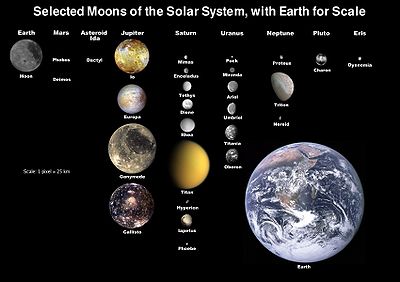
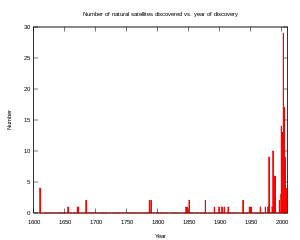
Mercury, the innermost planet, has no moons, or at least any that can be detected to a diameter of 1.6 km (1.0 mi).[1] For a brief time in 1974, Mercury was thought to have a moon.
Venus has no moons,[2] though reports of a moon around Venus have circulated since the 17th century.
Earth has one Moon, the largest of any rocky planet in the Solar System. It also has at least two co-orbitals: the asteroids 3753 Cruithne and 2002 AA29;[3] however, since they do not orbit Earth, they are not considered moons.
Mars has two known satellites, Phobos and Deimos, ("fear" and "panic", after attendants of Ares, the Greek god of war, equivalent to the Roman Mars). Searches for more satellites have been unsuccessful, putting the maximum radius of any other satellites at 90 m (100 yd).[4]
Jupiter has 63 known moons, 62 with secured orbits. Its eight regular moons are grouped into the planet-sized Galilean moons and the far smaller Amalthea group. They are named after lovers of Zeus, the Greek equivalent of Jupiter. Its 54 known irregular moons are organized into two categories: prograde and retrograde. The prograde satellites consist of the Himalia group and two others in groups of one. The retrograde moons are grouped into the Carme, Ananke and Pasiphaë groups, as well as some isolated moons.
Saturn has 62 moons with confirmed orbits, 53 of which have names, and most of which are quite small. Seven moons are large enough to be in hydrostatic equilibrium. Twenty-two of Saturn's moons are regular, and traditionally named after Titans or other figures associated with the mythological Saturn. The remaining thirty-eight, all small, are irregular, and classified by their orbital characteristics into Inuit, Norse, and Gallic groups, and their names are chosen from the corresponding mythologies. The rings of Saturn are made up of icy objects ranging in size from 1 centimetre to hundreds of metres, each of which is on its own orbit about the planet. Thus a precise number of Saturnian moons cannot be given, as there is no objective boundary between the countless small anonymous objects that form Saturn's ring system and the larger objects that have been named as moons. At least 150 "moonlets" embedded in the rings have been detected by the disturbance they create in the surrounding ring material, though this is thought to be only a small sample of the total population of such objects.
Uranus has 27 named moons, five of which are massive enough to have achieved hydrostatic equilibrium. There are 13 inner moons that orbit within Uranus's ring system, and another nine outer irregular moons. Unlike most planetary moons, which are named from antiquity, all the moons of Uranus are named after characters from the works of Shakespeare and Alexander Pope's work The Rape of the Lock.
Neptune has 13 named moons in its massively lopsided moon system; one moon, Triton, accounts for more than 99.5 percent of all the mass orbiting the planet. Triton is large enough to have achieved hydrostatic equilibrium, but, uniquely for a large moon, is irregular, suggesting it was captured. Neptune also has six known inner regular satellites, and six outer irregular satellites.
Among the dwarf planets, Ceres has no known moons. It is 90 percent certain that Ceres has no moons larger than 1 km in size, assuming that they would have the same albedo as Ceres itself.[5]
Pluto has three moons. Its largest moon Charon, named after the ferryman who took souls across the River Styx, is more than half as large as Pluto itself, and large enough to orbit a point outside Pluto's surface. In effect, each orbits the other, forming a binary system informally referred to as a double-dwarf-planet. Pluto's two other moons, Nix and Hydra, are far smaller and orbit the Pluto–Charon system.
Haumea has two moons, Namaka and Hi'iaka, of radii ~85 and ~155 km, respectively.
Makemake has no known moons. A satellite having 1% Makemake's brightness would have been detected if it had been located at an angular distance from Makemake farther than 0.4 arcseconds (0.0001 degrees).[6]
Eris has one known moon, Dysnomia. Its radius is currently not known, but is expected to be around 100 km.[7]
As of October 2009, 190 asteroid moons[8] and 63 Trans-Neptunian moons had been discovered.[8]
Moons of planets and dwarf planets
This is a list of all the moons of planets and dwarf planets in the Solar System. Those 19 moons that are large enough to have achieved hydrostatic equilibrium are listed in bold. The seven moons larger than dwarf planets are listed in bold and italic. Sidereal period differs from semi-major axis because it depends on the mass of the primary as well as the satellite's distance from it.
| Satellite of Earth | Satellites of Mars |
| Satellites of Jupiter | Satellites of Saturn |
| Satellites of Uranus | Satellites of Neptune |
| Satellites of Pluto | Satellites of Haumea |
| Satellite of Eris |
| Image | Numeral | Name | Mean radius (km) | Semi-major axis (km) | Sidereal period (d) (r = retrograde) |
Discovery date | Discovered by | Notes | Ref(s) | Planet |
|---|---|---|---|---|---|---|---|---|---|---|
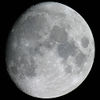 |
— | Moon | 1737.10 | 384,399 | 27.321582 | Prehistoric | — | Synchronous rotation | [9] | Earth |
|
|
I | Phobos | 11.1 ± 0.15 | 9,380 | 0.319 | 1877 (18 August) | Hall | [10][11][12] | Mars | |
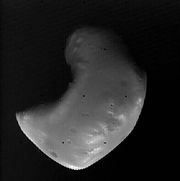 |
II | Deimos | 6.2 ± 0.18 | 23,460 | 1.262 | 1877 (12 August) | Hall | [10][11][12] | Mars | |
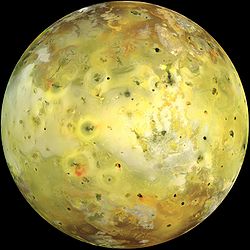 |
I | Io | 1818.1 ± 0.1 | 421,800 | 1.769 | 1610 | Galileo | Main group moon (Galilean) | [12][13] | Jupiter |
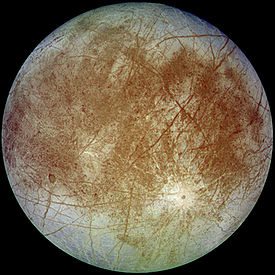 |
II | Europa | 1560.7 ± 0.7 | 671,100 | 3.551 | 1610 | Galileo | Main group moon (Galilean) | [12][13] | Jupiter |
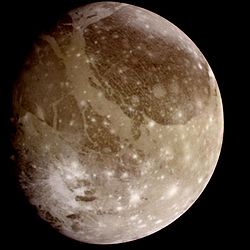 |
III | Ganymede | 2634.1 ± 0.3 | 1,070,400 | 7.155 | 1610 | Galileo | Main group moon (Galilean) | [12][13] | Jupiter |
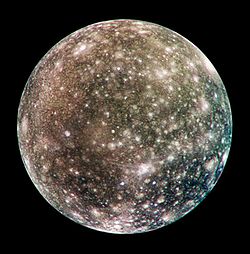 |
IV | Callisto | 2408.4 ± 0.3 | 1,882,700 | 16.69 | 1610 | Galileo | Main group moon (Galilean) | [12][13] | Jupiter |
|
|
V | Amalthea | 83.45 ± 2.4 | 181,400 | 0.498 | 1892 | Barnard | Inner moon (Amalthea) | [11][12][14] | Jupiter |
|
|
VI | Himalia | 85 | 11,461,000 | 250.56 | 1904 | Perrine | Prograde irregular (Himalia) | [11][12][15] | Jupiter |
 |
VII | Elara | 43 | 11,741,000 | 259.64 | 1905 | Perrine | Prograde irregular (Himalia) | [11][12][16] | Jupiter |
| VIII | Pasiphaë | 30 | 23,624,000 | 743.63 (r) | 1908 | Melotte | Retrograde irregular (Pasiphae) | [11][12][17] | Jupiter | |
| IX | Sinope | 19 | 23,939,000 | 758.90 (r) | 1914 | Nicholson | Retrograde irregular (Pasiphae) | [11][12][18] | Jupiter | |
| X | Lysithea | 18 | 11,717,000 | 259.20 | 1938 | Nicholson | Prograde irregular (Himalia) | [11][12][19] | Jupiter | |
| XI | Carme | 23 | 23,404,000 | 734.17 (r) | 1938 | Nicholson | Retrograde irregular (Carme) | [11][12][19] | Jupiter | |
| XII | Ananke | 14 | 21,276,000 | 629.77 (r) | 1951 | Nicholson | Retrograde irregular (Ananke) | [11][12][20] | Jupiter | |
| XIII | Leda | 10 | 11,165,000 | 240.92 | 1974 | Kowal | Prograde irregular (Himalia) | [11][12][21] | Jupiter | |
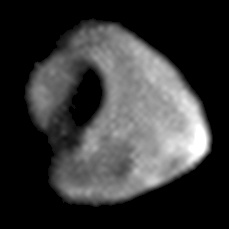 |
XIV | Thebe | 49.3 ± 2.0 | 221,900 | 0.675 | 1980 | Synnott (Voyager 1) | Inner moon (Amalthea) | [11][12][22] | Jupiter |
|
|
XV | Adrastea | 8.2 ± 2.0 | 129,000 | 0.298 | 1979 | Jewitt, Danielson (Voyager 1) | Inner moon (Amalthea) | [11][12][23] | Jupiter |
|
|
XVI | Metis | 21.5 ± 2.0 | 128,000 | 0.295 | 1979 | Synnott (Voyager 1) | Inner moon (Amalthea) | [11][12][24] | Jupiter |
| XVII | Callirrhoe | 4.3 | 24,103,000 | 758.77 (r) | 2000 | Scotti, Spahr, McMillan, Larsen, Montani, Gleason, Gehrels | Retrograde irregular (Pasiphae) | [11][12][25] | Jupiter | |
| XVIII | Themisto | 4.0 | 7,284,000 | 130.02 | 1975/2000 | Kowal and Roemer (original); Sheppard, Jewitt, Fernández, Magnier (rediscovery) | Prograde irregular | [11][12][26][27] | Jupiter | |
| XIX | Megaclite | 2.7 | 23,493,000 | 752.86 (r) | 2001 | Sheppard, Jewitt, Fernández, Magnier, Dahm, Evans | Retrograde irregular (Pasiphae) | [11][12][28] | Jupiter | |
| XX | Taygete | 2.5 | 23,280,000 | 732.41 (r) | 2001 | Sheppard, Jewitt, Fernández, Magnier, Dahm, Evans | Retrograde irregular (Carme) | [11][12][28] | Jupiter | |
| XXI | Chaldene | 1.9 | 23,100,000 | 723.72 (r) | 2001 | Sheppard, Jewitt, Fernández, Magnier, Dahm, Evans | Retrograde irregular (Carme) | [11][12][28] | Jupiter | |
| XXII | Harpalyke | 2.2 | 20,858,000 | 623.32 (r) | 2001 | Sheppard, Jewitt, Fernández, Magnier, Dahm, Evans | Retrograde irregular (Ananke) | [11][12][28] | Jupiter | |
| XXIII | Kalyke | 2.6 | 23,483,000 | 742.06 (r) | 2001 | Sheppard, Jewitt, Fernández, Magnier, Dahm, Evans | Retrograde irregular (Carme) | [11][12][28] | Jupiter | |
| XXIV | Iocaste | 2.6 | 21,060,000 | 631.60 (r) | 2001 | Sheppard, Jewitt, Fernández, Magnier, Dahm, Evans | Retrograde irregular (Ananke) | [11][12][28] | Jupiter | |
| XXV | Erinome | 1.6 | 23,196,000 | 728.46 (r) | 2001 | Sheppard, Jewitt, Fernández, Magnier, Dahm, Evans | Retrograde irregular (Carme) | [11][12][28] | Jupiter | |
| XXVI | Isonoe | 1.9 | 23,155,000 | 726.23 (r) | 2001 | Sheppard, Jewitt, Fernández, Magnier, Dahm, Evans | Retrograde irregular (Carme) | [11][12][28] | Jupiter | |
| XXVII | Praxidike | 3.4 | 20,908,000 | 625.39 (r) | 2001 | Sheppard, Jewitt, Fernández, Magnier, Dahm, Evans | Retrograde irregular (Ananke) | [11][12][28] | Jupiter | |
| XXVIII | Autonoe | 2.0 | 24,046,000 | 760.95 (r) | 2002 | Sheppard, Jewitt, Kleyna | Retrograde irregular (Pasiphae) | [11][12][29] | Jupiter | |
| XXIX | Thyone | 2.0 | 20,939,000 | 627.21 (r) | 2002 | Sheppard, Jewitt, Kleyna | Retrograde irregular (Ananke) | [11][12][29] | Jupiter | |
| XXX | Hermippe | 2.0 | 21,131,000 | 633.9 (r) | 2002 | Sheppard, Jewitt, Kleyna | Retrograde irregular (Ananke?) | [11][12][29] | Jupiter | |
| XXXI | Aitne | 1.5 | 23,229,000 | 730.18 (r) | 2002 | Sheppard, Jewitt, Kleyna | Retrograde irregular (Carme) | [11][12][29] | Jupiter | |
| XXXII | Eurydome | 1.5 | 22,865,000 | 717.33 (r) | 2002 | Sheppard, Jewitt, Kleyna | Retrograde irregular (Pasiphae?) | [11][12][29] | Jupiter | |
| XXXIII | Euanthe | 1.5 | 20,797,000 | 620.49 (r) | 2002 | Sheppard, Jewitt, Kleyna | Retrograde irregular (Ananke) | [11][12][29] | Jupiter | |
| XXXIV | Euporie | 1.0 | 19,304,000 | 550.74 (r) | 2002 | Sheppard, Jewitt, Kleyna | Retrograde irregular (Ananke) | [11][12][29] | Jupiter | |
| XXXV | Orthosie | 1.0 | 20,720,000 | 622.56 (r) | 2002 | Sheppard, Jewitt, Kleyna | Retrograde irregular (Ananke) | [11][12][29] | Jupiter | |
| XXXVI | Sponde | 1.0 | 23,487,000 | 748.34 (r) | 2002 | Sheppard, Jewitt, Kleyna | Retrograde irregular (Pasiphae) | [11][12][29] | Jupiter | |
| XXXVII | Kale | 1.0 | 23,217,000 | 729.47 (r) | 2002 | Sheppard, Jewitt, Kleyna | Retrograde irregular (Carme) | [11][12][29] | Jupiter | |
| XXXVIII | Pasithee | 1.0 | 23,004,000 | 719.44 (r) | 2002 | Sheppard, Jewitt, Kleyna | Retrograde irregular (Carme) | [11][12][29] | Jupiter | |
| XXXIX | Hegemone | 1.5 | 23,577,000 | 739.88 (r) | 2003 | Sheppard, Jewitt, Kleyna, Fernández | Retrograde irregular (Pasiphae) | [11][12] | Jupiter | |
| XL | Mneme | 1.0 | 21,035,000 | 620.04 (r) | 2003 | Gladman, Allen | Retrograde irregular (Ananke) | [11][12] | Jupiter | |
| XLI | Aoede | 2.0 | 23,980,000 | 761.50 (r) | 2003 | Sheppard, Jewitt, Kleyna, Fernández, Hsieh | Retrograde irregular (Pasiphae) | [11][12] | Jupiter | |
| XLII | Thelxinoe | 1.0 | 21,164,000 | 628.09 (r) | 2003 | Sheppard, Jewitt, Kleyna, Gladman, Kavelaars, Petit, Allen | Retrograde irregular (Ananke) | [11][12] | Jupiter | |
| XLIII | Arche | 1.5 | 23,355,000 | 731.95 (r) | 2002 | Sheppard, Meech, Hsieh, Tholen, Tonry | Retrograde irregular (Carme) | [11][12][29] | Jupiter | |
| XLIV | Kallichore | 1.0 | 23,288,000 | 728.73 (r) | 2003 | Sheppard, Jewitt, Kleyna, Fernández | Retrograde irregular (Carme?) | [11][12] | Jupiter | |
| XLV | Helike | 2.0 | 21,069,000 | 626.32 (r) | 2003 | Sheppard, Jewitt, Kleyna, Fernández, Hsieh | Retrograde irregular (Ananke) | [11][12] | Jupiter | |
| XLVI | Carpo | 1.5 | 17,058,000 | 456.30 | 2003 | Sheppard, Gladman, Kavelaars, Petit, Allen, Jewitt, Kleyna | Prograde irregular | [11][12] | Jupiter | |
| XLVII | Eukelade | 2.0 | 23,328,000 | 730.47 (r) | 2003 | Sheppard, Jewitt, Kleyna, Fernández, Hsieh | Retrograde irregular (Carme) | [11][12] | Jupiter | |
| XLVIII | Cyllene | 1.0 | 23,809,000 | 752 (r) | 2003 | Sheppard, Jewitt, Kleyna | Retrograde irregular (Pasiphae) | [11][12] | Jupiter | |
| XLIX | Kore | 1.0 | 24,543,000 | 779.17 (r) | 2003 | Sheppard, Jewitt, Kleyna | Retrograde irregular (Pasiphae) | [11][12] | Jupiter | |
| L | Herse | 1.0 | 22,983,000 | 714.51 (r) | 2003 | Gladman, Sheppard, Jewitt, Kleyna, Kavelaars, Petit, Allen | Retrograde irregular (Carme) | [11][12] | Jupiter | |
| — | S/2000 J 11 | 2.0 | 12,555,000 | 287 | 2000 | Sheppard, Jewitt, Fernández, Magnier, Dahm, Evans | Prograde irregular | [30][31] | Jupiter | |
| — | S/2003 J 2 | 1.0 | 28,455,000 | 981.55 (r) | 2003 | Sheppard, Jewitt, Kleyna, Fernández, Hsieh | Retrograde irregular | [11][12] | Jupiter | |
| — | S/2003 J 3 | 1.0 | 20,224,000 | 583.88 (r) | 2003 | Sheppard, Jewitt, Kleyna, Fernández, Hsieh | Retrograde irregular (Ananke) | [11][12] | Jupiter | |
| — | S/2003 J 4 | 1.0 | 23,933,000 | 755.26 (r) | 2003 | Sheppard, Jewitt, Kleyna, Fernández, Hsieh | Retrograde irregular (Pasiphae) | [11][12] | Jupiter | |
| — | S/2003 J 5 | 2.0 | 23,498,000 | 738.74 (r) | 2003 | Sheppard, Jewitt, Kleyna, Fernández, Hsieh | Retrograde irregular (Carme) | [11][12] | Jupiter | |
| — | S/2003 J 9 | 0.5 | 23,388,000 | 733.30 (r) | 2003 | Sheppard, Jewitt, Kleyna, Fernández | Retrograde irregular (Carme) | [11][12] | Jupiter | |
| — | S/2003 J 10 | 1.0 | 23,044,000 | 716.25 (r) | 2003 | Sheppard, Jewitt, Kleyna, Fernández | Retrograde irregular (Pasiphae?) | [11][12] | Jupiter | |
| — | S/2003 J 12 | 0.5 | 17,833,000 | 489.72 (r) | 2003 | Sheppard, Jewitt, Kleyna, Fernández | Retrograde irregular (Ananke) | [11][12] | Jupiter | |
| — | S/2003 J 15 | 1.0 | 22,630,000 | 689.77 (r) | 2003 | Sheppard, Jewitt, Kleyna, Fernández | Retrograde irregular (Ananke?) | [11][12] | Jupiter | |
| — | S/2003 J 16 | 1.0 | 20,956,000 | 616.33 (r) | 2003 | Gladman, Sheppard, Jewitt, Kleyna, Kavelaars, Petit, Allen | Retrograde irregular (Ananke) | [11][12] | Jupiter | |
| — | S/2003 J 18 | 1.0 | 20,426,000 | 596.58 (r) | 2003 | Gladman, Sheppard, Jewitt, Kleyna, Kavelaars, Petit, Allen | Retrograde irregular (Ananke) | [11][12] | Jupiter | |
| — | S/2003 J 19 | 1.0 | 23,535,000 | 740.43 (r) | 2003 | Gladman, Sheppard, Jewitt, Kleyna, Kavelaars, Petit, Allen | Retrograde irregular (Carme) | [11][12] | Jupiter | |
| — | S/2003 J 23 | 1.0 | 23,566,000 | 732.45 (r) | 2004 | Sheppard, Jewitt, Kleyna, Fernández | Retrograde irregular (Pasiphae) | [11][12] | Jupiter | |
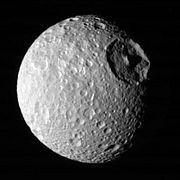 |
I | Mimas | 198.8 ± 1.5 | 185,540 | 0.942 | 1789 | Herschel | Main group moon | [11][12] | Saturn |
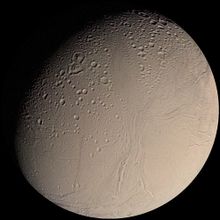 |
II | Enceladus | 252.3 ± 0.6 | 238,040 | 1.370 | 1789 | Herschel | Main group moon | [11][12] | Saturn |
 |
III | Tethys | 536.3 ± 1.5 | 294,670 | 1.888 | 1684 | Cassini | Main group moon (Sidera Lodoicea) | [11][12] | Saturn |
|
|
IV | Dione | 562.5 ± 1.5 | 377,420 | 2.737 | 1684 | Cassini | Main group moon (Sidera Lodoicea) | [11][12] | Saturn |
_thumb.jpg) |
V | Rhea | 764.5 ± 2.0 | 527,070 | 4.518 | 1672 | Cassini | Main group moon (Sidera Lodoicea) | [11][12] | Saturn |
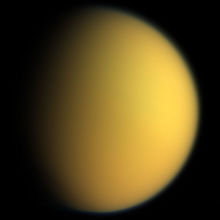 |
VI | Titan | 2575.5 ± 2.0 | 1,221,870 | 15.95 | 1655 | Huygens | Main group moon | [11][12] | Saturn |
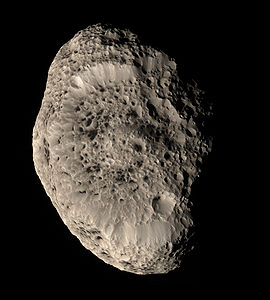 |
VII | Hyperion | 133.0 ± 8.0 | 1,500,880 | 21.28 | 1848 | W.Bond, G. Bond, and Lassell | Main group moon | [11][12] | Saturn |
 |
VIII | Iapetus | 734.5 ± 4.0 | 3,560,840 | 79.33 | 1671 | Cassini | Main group moon (Sidera Lodoicea) | [11][12] | Saturn |
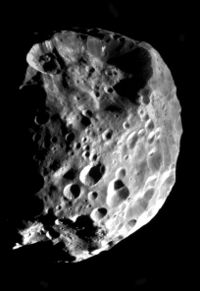 |
IX | Phoebe | 106.6 ± 1.1 | 12,947,780 | 550.31 (r) | 1899 | Pickering | Retrograde irregular (Norse) | [11][12] | Saturn |
 |
X | Janus | 90.4 ± 3.0 | 151,460 | 0.695 | 1966 | Dollfus; Voyager 1 | Inner moon (co-orbital) | [11][12] | Saturn |
 |
XI | Epimetheus | 58.3 ± 3.1 | 151,410 | 0.694 | 1980 | Walker; Voyager 1 | Inner moon (co-orbital) | [11][12] | Saturn |
|
|
XII | Helene | 16 ± 4 | 377,420 | 2.737 | 1980 | Laques, Lecacheux | Main group trojan | [11][12] | Saturn |
|
|
XIII | Telesto | 12 ± 3 | 294,710 | 1.888 | 1980 | Smith, Reitsema, Larson, Fountain (Voyager 1) | Main group trojan | [11][12] | Saturn |
|
|
XIV | Calypso | 9.5 ± 1.5 | 294,710 | 1.888 | 1980 | Pascu, Seidelmann, Baum, Currie | Main group trojan | [11][12] | Saturn |
 |
XV | Atlas | 15.3 ± 1.2 | 137,670 | 0.602 | 1980 | Terrile (Voyager 1) | Inner moon (shepherd) | [11][12] | Saturn |
 |
XVI | Prometheus | 46.8 ± 5.6 | 139,380 | 0.613 | 1980 | Collins (Voyager 1) | Inner moon (shepherd) | [11][12] | Saturn |
|
|
XVII | Pandora | 40.6 ± 4.5 | 141,720 | 0.629 | 1980 | Collins (Voyager 1) | Inner moon (shepherd) | [11][12] | Saturn |
|
|
XVIII | Pan | 12.8 | 133,580 | 0.575 | 1990 | Showalter (Voyager 2) | Inner moon (shepherd) | [11][12] | Saturn |
| XIX | Ymir | 9 | 23,040,000 | 1,315.14 (r) | 2000 | Gladman | Retrograde irregular (Norse) | [11][12] | Saturn | |
| XX | Paaliaq | 11 | 15,200,000 | 686.95 | 2000 | Gladman | Prograde irregular (Inuit) | [11][12] | Saturn | |
| XXI | Tarvos | 7.5 | 17,983,000 | 926.23 | 2000 | Gladman, Kavelaars | Prograde irregular (Gallic) | [11][12] | Saturn | |
| XXII | Ijiraq | 6 | 11,124,000 | 451.42 | 2000 | Gladman, Kavelaars | Prograde irregular (Inuit) | [11][12] | Saturn | |
| XXIII | Suttungr | 3.5 | 19,459,000 | 1,016.67 (r) | 2000 | Gladman, Kavelaars | Retrograde irregular (Norse) | [11][12] | Saturn | |
| XXIV | Kiviuq | 8 | 11,110,000 | 449.22 | 2000 | Gladman | Prograde irregular (Inuit) | [11][12] | Saturn | |
| XXV | Mundilfari | 3.5 | 18,628,000 | 952.77 (r) | 2000 | Gladman, Kavelaars | Retrograde irregular (Norse) | [11][12] | Saturn | |
| XXVI | Albiorix | 16 | 16,182,000 | 783.45 | 2000 | Holman, Spahr | Prograde irregular (Gallic) | [11][12] | Saturn | |
| XXVII | Skathi | 4 | 15,540,000 | 728.20 (r) | 2000 | Gladman, Kavelaars | Retrograde irregular (Norse) | [11][12] | Saturn | |
| XXVIII | Erriapus | 5 | 17,343,000 | 871.19 | 2000 | Gladman, Kavelaars | Prograde irregular (Gallic) | [11][12] | Saturn | |
| XXIX | Siarnaq | 20 | 17,531,000 | 895.53 | 2000 | Gladman, Kavelaars | Prograde irregular (Inuit) | [11][12] | Saturn | |
| XXX | Thrymr | 3.5 | 20,314,000 | 1,094.11 (r) | 2000 | Gladman, Kavelaars | Retrograde irregular (Norse) | [11][12] | Saturn | |
| XXXI | Narvi | 3.5 | 19,007,000 | 1,003.86 (r) | 2003 | Sheppard, Jewitt, Kleyna | Retrograde irregular (Norse) | [11][12] | Saturn | |
| XXXII | Methone | 1.5 | 194,440 | 1.010 | 2004 | Porco, Charnoz, Brahic, Dones (Cassini-Huygens) | Alcyonid moon | [12] | Saturn | |
|
|
XXXIII | Pallene | 2 | 212,280 | 1.154 | 2004 | Gordon, Murray, Beurle, et al. (Cassini-Huygens) | Alcyonid moon | [12] | Saturn |
|
|
XXXIV | Polydeuces | 1.25 | 377,200 | 2.737 | 2004 | Porco et al. (Cassini-Huygens) | Main group trojan | [12] | Saturn |
|
|
XXXV | Daphnis | 3–4 | 136,500 | 0.594 | 2005 | Porco et al. (Cassini-Huygens) | Inner moon (shepherd) | [12] | Saturn |
| XXXVI | Aegir | 3 | 20,751,000 | 1,117.52 (r) | 2004 | Sheppard, Jewitt, Kleyna, Marsden | Retrograde irregular (Norse) | [11][12] | Saturn | |
| XXXVII | Bebhionn | 3 | 17,119,000 | 834.84 | 2004 | Sheppard, Jewitt, Kleyna, Marsden | Prograde irregular (Gallic) | [11][12] | Saturn | |
| XXXVIII | Bergelmir | 3 | 19,336,000 | 1,005.74 (r) | 2004 | Sheppard, Jewitt, Kleyna, Marsden | Retrograde irregular (Norse) | [11][12] | Saturn | |
| XXXIX | Bestla | 3.5 | 20,192,000 | 1,088.72 (r) | 2004 | Sheppard, Jewitt, Kleyna, Marsden | Retrograde irregular (Norse) | [11][12] | Saturn | |
| XL | Farbauti | 2.5 | 20,377,000 | 1,085.55 (r) | 2004 | Sheppard, Jewitt, Kleyna, Marsden | Retrograde irregular (Norse) | [11][12] | Saturn | |
| XLI | Fenrir | 2 | 22,454,000 | 1,260.35 (r) | 2004 | Sheppard, Jewitt, Kleyna, Marsden | Retrograde irregular (Norse) | [11][12] | Saturn | |
| XLII | Fornjot | 3 | 25,146,000 | 1,494.2 (r) | 2004 | Sheppard, Jewitt, Kleyna, Marsden | Retrograde irregular (Norse) | [11][12] | Saturn | |
| XLIII | Hati | 3 | 19,846,000 | 1,038.61 (r) | 2004 | Sheppard, Jewitt, Kleyna, Marsden | Retrograde irregular (Norse) | [11][12] | Saturn | |
| XLIV | Hyrrokkin | 4 | 18,437,000 | 931.86 (r) | 2006 | Sheppard, Jewitt, Kleyna | Retrograde irregular (Norse) | [12] | Saturn | |
| XLV | Kari | 3.5 | 22,089,000 | 1,230.97 (r) | 2006 | Sheppard, Jewitt, Kleyna | Retrograde irregular (Norse) | [12] | Saturn | |
| XLVI | Loge | 3 | 23,058,000 | 1,311.36 (r) | 2006 | Sheppard, Jewitt, Kleyna | Retrograde irregular (Norse) | [12] | Saturn | |
| XLVII | Skoll | 3 | 17,665,000 | 878.29 (r) | 2006 | Sheppard, Jewitt, Kleyna | Retrograde irregular (Norse) | [12] | Saturn | |
| XLVIII | Surtur | 3 | 22,704,000 | 1,297.36 (r) | 2006 | Sheppard, Jewitt, Kleyna | Retrograde irregular (Norse) | [12] | Saturn | |
| XLIX | Anthe | 1 | 197,700 | 1.0365 | 2007 | Porco et al. (Cassini-Huygens) | Alcyonid moon | [32] | Saturn | |
| L | Jarnsaxa | 3 | 18,811,000 | 964.74 (r) | 2006 | Sheppard, Jewitt, Kleyna | Retrograde irregular (Norse) | [12] | Saturn | |
| LI | Greip | 3 | 18,206,000 | 921.19 (r) | 2006 | Sheppard, Jewitt, Kleyna | Retrograde irregular (Norse) | [12] | Saturn | |
| LII | Tarqeq | 3.5 | 18,009,000 | 887.48 | 2007 | Sheppard, Jewitt, Kleyna | Prograde irregular (Inuit) | [12] | Saturn | |
| LIII | Aegaeon | 0.25 | 167,500 | 0.808 | 2008 | Cassini Imaging Science Team Cassini-Huygens | G-ring moonlet | [33] | Saturn | |
| — | S/2004 S 7 | 3 | 20,999,000 | 1,140.24 (r) | 2004 | Sheppard, Jewitt, Kleyna, Marsden | Retrograde irregular (Norse) | [11][12] | Saturn | |
| — | S/2004 S 12 | 2.5 | 19,878,000 | 1,046.19 (r) | 2004 | Sheppard, Jewitt, Kleyna, Marsden | Retrograde irregular (Norse) | [11][12] | Saturn | |
| — | S/2004 S 13 | 3 | 18,404,000 | 933.48 (r) | 2004 | Sheppard, Jewitt, Kleyna, Marsden | Retrograde irregular (Norse) | [11][12] | Saturn | |
| — | S/2004 S 17 | 2 | 19,447,000 | 1,014.70 (r) | 2004 | Sheppard, Jewitt, Kleyna, Marsden | Retrograde irregular (Norse) | [11][12] | Saturn | |
| — | S/2006 S 1 | 3 | 18,790,000 | 963.37 (r) | 2006 | Sheppard, Jewitt, Kleyna | Retrograde irregular (Norse) | [12] | Saturn | |
| — | S/2006 S 3 | 3 | 22,096,000 | 1,227.21 (r) | 2006 | Sheppard, Jewitt, Kleyna | Retrograde irregular (Norse) | [12] | Saturn | |
| — | S/2007 S 2 | 3 | 16,725,000 | 808.08 (r) | 2007 | Sheppard, Jewitt, Kleyna | Retrograde irregular (Norse) | [12] | Saturn | |
| — | S/2007 S 3 | 3 | 18,975,000 | 977.8 (r) | 2007 | Sheppard, Jewitt, Kleyna | Retrograde irregular (Norse) | [12] | Saturn | |
| — | S/2009 S 1 | 0.3 | 117,000 | ? | 2009 | Cassini Imaging Science Team Cassini-Huygens | B-ring | [34] | Saturn | |
.jpg) |
I | Ariel | 578.9 ± 0.6 | 190,900 | 2.520 | 1851 | Lassell | Main group moon | [11][12] | Uranus |
.jpg) |
II | Umbriel | 584.7 ± 2.8 | 266,000 | 4.144 | 1851 | Lassell | Main group moon | [11][12] | Uranus |
_color_cropped.jpg) |
III | Titania | 788.9 ± 1.8 | 436,300 | 8.706 | 1787 | Herschel | Main group moon | [11][12] | Uranus |
|
|
IV | Oberon | 761.4 ± 2.6 | 583,500 | 13.46 | 1787 | Herschel | Main group moon | [11][12] | Uranus |
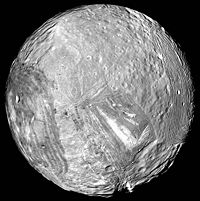 |
V | Miranda | 235.8 ± 0.7 | 129,900 | 1.413 | 1948 | Kuiper | Main group moon | [11][12] | Uranus |
| VI | Cordelia | 20.1 ± 3 | 49,800 | 0.335 | 1986 | Terrile (Voyager 2) | Inner moon (shepherd) | [11][12] | Uranus | |
| VII | Ophelia | 21.4 ± 4 | 53,800 | 0.376 | 1986 | Terrile (Voyager 2) | Inner moon (shepherd) | [11][12] | Uranus | |
| VIII | Bianca | 25.7 ± 2 | 59,200 | 0.435 | 1986 | Smith (Voyager 2) | Inner moon | [11][12] | Uranus | |
| IX | Cressida | 39.8 ± 2 | 61,800 | 0.464 | 1986 | Synnott (Voyager 2) | Inner moon | [11][12] | Uranus | |
| X | Desdemona | 32.0 ± 4 | 62,700 | 0.474 | 1986 | Synnott (Voyager 2) | Inner moon | [11][12] | Uranus | |
| XI | Juliet | 46.8 ± 4 | 64,400 | 0.493 | 1986 | Synnott (Voyager 2) | Inner moon | [11][12] | Uranus | |
| XII | Portia | 67.6 ± 4 | 66,100 | 0.513 | 1986 | Synnott (Voyager 2) | Inner moon | [11][12] | Uranus | |
| XIII | Rosalind | 36 ± 6 | 69,900 | 0.558 | 1986 | Synnott (Voyager 2) | Inner moon | [11][12] | Uranus | |
| XIV | Belinda | 40.3 ± 8 | 75,300 | 0.624 | 1986 | Synnott (Voyager 2) | Inner moon | [11][12] | Uranus | |
|
|
XV | Puck | 81 ± 2 | 86,000 | 0.762 | 1985 | Synnott (Voyager 2) | Inner moon | [11][12] | Uranus |
| XVI | Caliban | 49 | 7,231,000 | 579.73 (r) | 1997 | Gladman, Nicholson, Burns, Kavelaars | Retrograde irregular | [11][12] | Uranus | |
| XVII | Sycorax | 95 | 12,179,000 | 1,288.3 (r) | 1997 | Gladman, Nicholson, Burns, Kavelaars | Retrograde irregular | [11][12] | Uranus | |
| XVIII | Prospero | 15 | 16,256,000 | 1,978.29 (r) | 1999 | Gladman, Holman, Kavelaars, Petit, Scholl | Retrograde irregular | [11][12] | Uranus | |
| XIX | Setebos | 15 | 17,418,000 | 2,225.21 (r) | 1999 | Gladman, Holman, Kavelaars, Petit, Scholl | Retrograde irregular | [11][12] | Uranus | |
| XX | Stephano | 10 | 8,004,000 | 677.36 (r) | 1999 | Gladman, Holman, Kavelaars, Petit, Scholl | Retrograde irregular | [11][12] | Uranus | |
| XXI | Trinculo | 5 | 8,504,000 | 749.24 (r) | 2001 | Holman, Kavelaars, Milisavljevic | Retrograde irregular | [11][12] | Uranus | |
| XXII | Francisco | 6 | 4,276,000 | 266.56 (r) | 2001 | Holman, Kavelaars, Milisavljevic, Gladman | Retrograde irregular | [11][12] | Uranus | |
| XXIII | Margaret | 5.5 | 14,345,000 | 1,687.01 | 2003 | Sheppard, Jewitt | Prograde irregular | [11][12] | Uranus | |
| XXIV | Ferdinand | 6 | 20,901,000 | 2,887.21 (r) | 2001 | Holman, Kavelaars, Milisavljevic, et al. | Retrograde irregular | [11][12] | Uranus | |
| XXV | Perdita | 10 | 76,417 | 0.638 | 1986 | Karkoschka (Voyager 2) | Inner moon | [12] | Uranus | |
| XXVI | Mab | 5 | 97,736 | 0.923 | 2003 | Showalter, Lissauer | Inner moon | [12] | Uranus | |
| XXVII | Cupid | 5 | 74,392 | 0.613 | 2003 | Showalter, Lissauer | Inner moon | [12] | Uranus | |
.jpg) |
I | Triton | 1353.4 ± 0.9 | 354,800 | 5.877 (r) | 1846 | Lassell | Main group moon (retrograde) | [11][12] | Neptune |
 |
II | Nereid | 170 ± 25 | 5,513,400 | 360.14 | 1949 | Kuiper | Prograde irregular | [11][12] | Neptune |
| III | Naiad | 33 ± 3 | 48,227 | 0.294 | 1989 | Terrile (Voyager 2) | Inner moon | [11][12] | Neptune | |
| IV | Thalassa | 41 ± 3 | 50,075 | 0.311 | 1989 | Terrile (Voyager 2) | Inner moon | [11][12] | Neptune | |
| V | Despina | 75 ± 3 | 52,526 | 0.335 | 1989 | Synnott (Voyager 2) | Inner moon | [11][12] | Neptune | |
| VI | Galatea | 88 ± 4 | 61,953 | 0.429 | 1989 | Synnott (Voyager 2) | Inner moon | [11][12] | Neptune | |
|
|
VII | Larissa | 97 ± 3 | 73,548 | 0.555 | 1989 | Reitsema, Hubbard, Lebofsky, Tholen (Voyager 2) | Inner moon | [11][12] | Neptune |
.jpg) |
VIII | Proteus | 210 ± 7 | 117,647 | 1.122 | 1989 | Synnott (Voyager 2) | Inner moon | [11][12] | Neptune |
| IX | Halimede | 31 | 15,728,000 | 1,879.71 (r) | 2003 | Holman, Kavelaars, Grav, Fraser, Milisavljevic | Retrograde irregular | [11][12] | Neptune | |
| X | Psamathe | 20 | 46,695,000 | 9,115.91 (r) | 2003 | Jewitt, Kleyna, Sheppard, Holman, Kavelaars | Retrograde irregular | [11][12] | Neptune | |
| XI | Sao | 22 | 22,422,000 | 2,914.07 | 2003 | Holman, Kavelaars, Grav, Fraser, Milisavljevic | Prograde irregular | [11][12] | Neptune | |
| XII | Laomedeia | 21 | 23,571,000 | 3,167.85 | 2003 | Holman, Kavelaars, Grav, Fraser, Milisavljevic | Prograde irregular | [11][12] | Neptune | |
| XIII | Neso | 30 | 48,387,000 | 9,373.99 (r) | 2003 | Holman, Kavelaars, Grav, Fraser, Milisavljevic | Retrograde irregular | [11][12] | Neptune | |
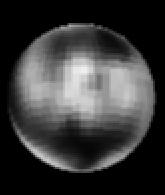 |
I | Charon | 593. ± 13. | 17,536 | 6.387 | 1978 | Christy | Image courtesy of Marc W. Buie/Lowell Observatory[35] | [11][12] | Pluto |
| II | Nix | 23–67.5 | 48,708 | 24.86 | 2005 | Weaver, Stern Buie, et al. | [12] | Pluto | ||
| III | Hydra | 30.5–83.5 | 64,749 | 38.20 | 2005 | Weaver, Stern Buie, et al. | [12] | Pluto | ||
| I | Hiʻiaka | 155 | 49,500 ± 400 | 49.12 ± 0.03 | 2005 | Brown et al. | [36] | Haumea | ||
| II | Namaka | 85 | 39,000 (r) | 34.7 ± 0.1 if e = 0 |
2005 | Brown et al. | [36] | Haumea | ||
| I | Dysnomia | 150[37] | 37,370 ± 150 | 15.774 ± 0.002 | 2005 | Brown, Rabinowitz, Trujillo et al. | SDO moon | [38][39][40] | Eris |
|
||||||||||||||||||||||||||||||||||||||||||||||||||||||||||||||||||||||||||||||||||||||||||||||||||||||||||||||||||||||||||||||||||||||||||||||||||||
References
- ↑ Warell, J.; Karlsson, O. (2007). "A search for natural satellites of Mercury". Planetary and Space Science 55 (14): 2037–2041. doi:10.1016/j.pss.2007.06.004. http://adsabs.harvard.edu/abs/2007P&SS...55.2037W.
- ↑ "Solar System Exploration: Planets: Venus: Moons". NASA. http://solarsystem.nasa.gov/planets/profile.cfm?Object=Venus&Display=Moons. Retrieved 2008-03-16.
- ↑ Whitehouse, David (21 October 2002). "Earth's little brother found". BBC News. http://news.bbc.co.uk/1/hi/sci/tech/2347663.stm. Retrieved 2007-03-31.
- ↑ Sheppard, Scott; et al. (2004). "A Survey for Outer Satellites of Mars: Limits to Completeness". arXiv:astro-ph/0409522. http://arxiv.org/abs/astro-ph/0409522.
- ↑ Bieryla, Allyson; Parker, J. W.. "Search for Satellites around Ceres". 2007 AAS/AAPT Joint Meeting, American Astronomical Society Meeting 209, #25.02; Bulletin of the American Astronomical Society 38: 933. http://adsabs.harvard.edu/abs/2006AAS...209.2502B.
- ↑ M. E. Brown, M. A. van Dam, A. H. Bouchez, et al. (2006-03-01). "Satellites of the Largest Kuiper Belt Objects". The Astrophysical Journal 639: L43–L46. doi:10.1086/501524. http://adsabs.harvard.edu/abs/2006ApJ...639L..43B.
- ↑ Johnston, Robert (21 August 2007). "(136199) Eris and Dysnomia". http://www.johnstonsarchive.net/astro/astmoons/am-136199.html. Retrieved 2008-03-12.
- ↑ 8.0 8.1 "Satellites and Companions of Minor Planets". Minor Planet Center. http://www.cfa.harvard.edu/iau/minorsats.html. Retrieved 2008-11-13.
- ↑ Wieczorek, M.; et al. (2006). "The constitution and structure of the lunar interior". Reviews in Mineralogy and Geochemistry 60: 221–364. doi:10.2138/rmg.2006.60.3.
- ↑ 10.0 10.1 "Notes: The Satellites of Mars". The Observatory 1 (6): 181–185. 20 September 1877. http://adsabs.harvard.edu//full/seri/Obs../0001//0000181.000.html. Retrieved 2008-03-09.
- ↑ 11.000 11.001 11.002 11.003 11.004 11.005 11.006 11.007 11.008 11.009 11.010 11.011 11.012 11.013 11.014 11.015 11.016 11.017 11.018 11.019 11.020 11.021 11.022 11.023 11.024 11.025 11.026 11.027 11.028 11.029 11.030 11.031 11.032 11.033 11.034 11.035 11.036 11.037 11.038 11.039 11.040 11.041 11.042 11.043 11.044 11.045 11.046 11.047 11.048 11.049 11.050 11.051 11.052 11.053 11.054 11.055 11.056 11.057 11.058 11.059 11.060 11.061 11.062 11.063 11.064 11.065 11.066 11.067 11.068 11.069 11.070 11.071 11.072 11.073 11.074 11.075 11.076 11.077 11.078 11.079 11.080 11.081 11.082 11.083 11.084 11.085 11.086 11.087 11.088 11.089 11.090 11.091 11.092 11.093 11.094 11.095 11.096 11.097 11.098 11.099 11.100 11.101 11.102 11.103 11.104 11.105 11.106 11.107 11.108 11.109 11.110 11.111 11.112 11.113 11.114 11.115 11.116 11.117 11.118 11.119 11.120 11.121 11.122 11.123 11.124 11.125 11.126 11.127 11.128 11.129 11.130 11.131 11.132 11.133 11.134 11.135 11.136 11.137 11.138 11.139 11.140 "Planetary Satellite Physical Parameters". JPL, NASA. 13 July 2006. http://ssd.jpl.nasa.gov/?sat_phys_par. Retrieved 2008-03-09., and references therein.
- ↑ 12.000 12.001 12.002 12.003 12.004 12.005 12.006 12.007 12.008 12.009 12.010 12.011 12.012 12.013 12.014 12.015 12.016 12.017 12.018 12.019 12.020 12.021 12.022 12.023 12.024 12.025 12.026 12.027 12.028 12.029 12.030 12.031 12.032 12.033 12.034 12.035 12.036 12.037 12.038 12.039 12.040 12.041 12.042 12.043 12.044 12.045 12.046 12.047 12.048 12.049 12.050 12.051 12.052 12.053 12.054 12.055 12.056 12.057 12.058 12.059 12.060 12.061 12.062 12.063 12.064 12.065 12.066 12.067 12.068 12.069 12.070 12.071 12.072 12.073 12.074 12.075 12.076 12.077 12.078 12.079 12.080 12.081 12.082 12.083 12.084 12.085 12.086 12.087 12.088 12.089 12.090 12.091 12.092 12.093 12.094 12.095 12.096 12.097 12.098 12.099 12.100 12.101 12.102 12.103 12.104 12.105 12.106 12.107 12.108 12.109 12.110 12.111 12.112 12.113 12.114 12.115 12.116 12.117 12.118 12.119 12.120 12.121 12.122 12.123 12.124 12.125 12.126 12.127 12.128 12.129 12.130 12.131 12.132 12.133 12.134 12.135 12.136 12.137 12.138 12.139 12.140 12.141 12.142 12.143 12.144 12.145 12.146 12.147 12.148 12.149 12.150 12.151 12.152 12.153 12.154 12.155 12.156 12.157 12.158 12.159 12.160 12.161 12.162 12.163 12.164 12.165 "Planetary Satellite Mean Orbital Parameters". JPL, NASA. http://ssd.jpl.nasa.gov/?sat_elem. Retrieved 2008-03-09., and references therein.
- ↑ 13.0 13.1 13.2 13.3 Showman, Adam P.; Malhotra, Renu (1999). "The Galilean Satellites" (PDF). Science 286: 77–84. doi:10.1126/science.286.5437.77. PMID 10506564. http://www.lpl.arizona.edu/~showman/publications/showman-malhotra-1999.pdf.
- ↑ Barnard, E. E. (1892). "Discovery and Observation of a Fifth Satellite to Jupiter". Astronomical Journal 12: 81–85. doi:10.1086/101715. http://adsabs.harvard.edu//full/seri/AJ.../0012//0000081.000.html.
- ↑ Crommelin, A. C. D. (10 March 1905). "Provisional Elements of Jupiter's Satellite VI". Monthly Notices of the Royal Astronomical Society 65 (5): 524–527. http://adsabs.harvard.edu/cgi-bin/nph-bib_query?1905MNRAS..65..524C.
- ↑ Perrine, C. D. (1905). "The Seventh Satellite of Jupiter". Publications of the Astronomical Society of the Pacific 17 (101): 62–63. http://adsabs.harvard.edu//full/seri/PASP./0017//0000062.000.html.
- ↑ Melotte, P. J. (1908). "Note on the Newly Discovered Eighth Satellite of Jupiter, Photographed at the Royal Observatory, Greenwich". Monthly Notices of the Royal Astronomical Society 68 (6): 456–457. http://adsabs.harvard.edu/cgi-bin/nph-data_query?bibcode=1908MNRAS..68..456.&db_key=AST&link_type=ABSTRACT&high=40daf3f6f927275.
- ↑ Nicholson, S. B. (1914). "Discovery of the Ninth Satellite of Jupiter". Publications of the Astronomical Society of the Pacific 26: 197–198. doi:10.1086/122336. http://adsabs.harvard.edu//full/seri/PASP./0026//0000197.000.html.
- ↑ 19.0 19.1 Nicholson, S.B. (1938). "Two New Satellites of Jupiter". Publications of the Astronomical Society of the Pacific 50: 292–293. doi:10.1086/124963. http://adsabs.harvard.edu//full/seri/PASP./0050//0000292.000.html.
- ↑ Nicholson, S. B. (1951). "An unidentified object near Jupiter, probably a new satellite". Publications of the Astronomical Society of the Pacific 63 (375): 297–299. doi:10.1086/126402. http://adsabs.harvard.edu//full/seri/PASP./0063//0000297.000.html.
- ↑ Kowal, C. T.; Aksnes, K.; Marsden, B. G.; and Roemer, E. (1974). "Thirteenth satellite of Jupiter". Astronomical Journal 80: 460–464. doi:10.1086/111766. http://adsabs.harvard.edu//full/seri/AJ.../0080//0000460.000.html.
- ↑ Synnott, S.P. (1980). "1979J2: The Discovery of a Previously Unknown Jovian Satellite". Science 210 (4471): 786–788. doi:10.1126/science.210.4471.786. PMID 17739548. http://links.jstor.org/sici?sici=0036-8075%2819801114%293210:4471%3c786:1TDOAP%3e2.0.CO%3b2-1&origin=ads.
- ↑ Jewitt, D.C.; Danielson, G.E.; Synnott, S.P. (1979). "Discovery of a New Jupiter Satellite". Science 206 (4421): 951. doi:10.1126/science.206.4421.951. PMID 17733911. http://links.jstor.org/sici?sici=0036-8075%2819791123%293206:4421%3c951:DOANJS%3e2.0.CO%3b2-V&origin=ads.
- ↑ Synnott, S.P. (1981). "1979J3: Discovery of a Previously Unknown Satellite of Jupiter". Science 212 (4501): 1392. doi:10.1126/science.212.4501.1392. PMID 17746259. http://links.jstor.org/sici?sici=0036-8075%2819810619%293212:4501%3c1392:1DOAPU%3e2.0.CO%3b2-X&origin=ads.
- ↑ "IAUC 7460: S/1999 J 1". 20 July 2000. http://cfa-www.harvard.edu/iauc/07400/07460.html. Retrieved 2008-03-13.
- ↑ "IAUC 2845: Probable New Satellite of Jupiter". 3 October 1975. http://cfa-www.harvard.edu/iauc/02800/02845.html. Retrieved 2008-03-13.
- ↑ "IAUC 7525: S/1975 J 1 = S/2000 J 1". 25 November 2000. http://cfa-www.harvard.edu/iauc/07500/07525.html. Retrieved 2008-03-13.
- ↑ 28.0 28.1 28.2 28.3 28.4 28.5 28.6 28.7 28.8 "IAUC 7555: Satellites of Jupiter". 5 January 2001. http://cfa-www.harvard.edu/iauc/07500/07555.html. Retrieved 2008-03-13.
- ↑ 29.00 29.01 29.02 29.03 29.04 29.05 29.06 29.07 29.08 29.09 29.10 29.11 "IAUC 7900: Satellites of Jupiter". 16 May 2002. http://cfa-www.harvard.edu/iauc/07900/07900.html. Retrieved 2008-03-13.
- ↑ "IAUC 7555: Satellites of Jupiter". 5 January 2001. http://cfa-www.harvard.edu/iauc/07500/07555.html. Retrieved 2008-03-14.
- ↑ Sheppard, S. S.; Jewitt, D. C.; Porco, C.; (2004). Fran Bagenal, Timothy E. Dowling, William B. McKinnon, Cambridge Planetary Science, Vol. 1. ed (PDF). Jupiter's outer satellites and Trojans, in Jupiter: The planet, satellites and magnetosphere,. Cambridge, UK: Cambridge University Press. pp. 263–280. ISBN 0-521-81808-7. http://www.ifa.hawaii.edu/~jewitt/papers/JUPITER/JSP.2003.pdf.
- ↑ C. Porco and the Cassini Imaging Team (2007-07-18). "S/ 2007 S 4". International Astronomical Union Circulars 8857 (subscription required). http://cfa-www.harvard.edu/iauc/08800/08857.html.
- ↑ "IAU Circular No. 9023". International Astronomical Union. 2009. http://ciclops.org/view/5518/S2008_S_1?js=1. Retrieved 2009-03-06.
- ↑ "IAU Circular No. 9091". International Astronomical Union. 2009. http://ciclops.org/view_popup.php?id=5926. Retrieved 2010-01-17.
- ↑ Buie: Mapping the surface of Pluto and Charon
- ↑ 36.0 36.1 D. C. Fabrycky, M. J. Holman, D. Ragozzine, M. E. Brown, T. A. Lister, D. M. Terndrup, J. Djordjevic, E. F. Young, L. A. Young, R. R. Howell. "Mutual Events of 2003 EL61 and its Inner Satellite". AAS DPS conference 2008. http://www.abstractsonline.com/viewer/viewAbstract.asp?CKey={DC1A2D7A-1E8E-4C58-A2AB-F0FA8673515C}&MKey={35A8F7D5-A145-4C52-8514-0B0340308E94}&AKey={AAF9AABA-B0FF-4235-8AEC-74F22FC76386}&SKey={545CAD5F-068B-4FFC-A6E2-1F2A0C6ED978}. Retrieved 2008-10-17.
- ↑ maximum
- ↑ Brown, M. E.; Schaller, E. L. (2007). "The Mass of Dwarf Planet Eris". Science 316: 1585. doi:10.1126/science.1139415. PMID 17569855. (Including supplementary material.)
- ↑ "Dwarf Planet Outweighs Pluto". space.com. 2007. http://www.space.com/scienceastronomy/070614_eris_mass.html. Retrieved 2007-06-14.
- ↑ Brown, M. E.; et al. (2006). "Satellites of the Largest Kuiper Belt Objects". Astrophysical Journal 639: L43–L46. doi:10.1086/501524. http://adsabs.harvard.edu/abs/2006ApJ...639L..43B.